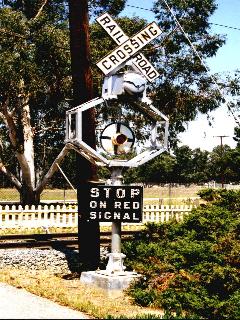| According to Pacific Electric Magazine (Dec. 1926), the
idea of the "wigwag" automatic flagman was was conceived by J. B. Hunt.
He was connected with the original Pacific Electric system in the Telephone
and Signal Department. It was later developed and perfected by that company.
The first automatic flagman on the Pacific Electric was installed in 1910.
The first 117 wigwags were gear driven, but later replaced by the magnetic
flagman type that is still in use today. I'm not exactly sure how and when
the Magnetic Signal Company came into being, but their first patent date
was May 19, 1914. I'm still searching for specific info on the company.
Sometime during the mid 1940's, (presumably right after the war) the company was bought out by Griswold Signal Company, and operations moved to Minneapolis. They continued to produce new wigwags until about 1949, then continued to make replacement parts until 1960. After that, railroads pretty much lived on back stock as well as parts from recently retired wigwags. New installations of wigwags pretty much ended during the late 30's and early 40's. By then, most cities required more modern forms of crossing protection. The majority of installations disappeared from the late 50's through the early 70's. |
For Manual images, click here.
|
LOS ANGELES CAL |
MINNEAPOLIS MINN |
|
|
Model 3
|
Reedly, Ca. 1999 (former SP) |
Model 3 Plans |
| This is by far the most popular style wigwag produced. At one time this type of wigwag numbered in the thousands on the Southern Pacific. They seemed to be the only road to set them up this way, right out of the Magnetic Signal catalogue. It's still a mystery to me as to why they chose to use those heavy cast iron bases. Most remained empty, with relays being housed in a separate box near the crossing. In a few instances, the Magnetic Signal base was substituted with a single Union Switch and Signal case. |
| This is basically the same type of installation, with
the exception of the base. This was also very common on Southern Pacific,
as well as Western Pacific. WP wasn't really known for wigwags, but they
did use them. They were a big customer for Union Switch and Signal when
the highway flasher was introduced.
Both of these styles used 4" pole with varying sized cantilevers. |
Model 10
"Santa Fe" Style
| Santa Fe definitely went with their own look. One of the most popular styles for them was the short (4 foot) cantilever mounted on 5" pole. Unlike SP, all had crossbucks and multi-tracks signs (where applicable) mounted to the mast. Some used a pinnacle at the top of the mast, while others utilized a power drop. There were actually two ways of setting these up, see below. |
|
Redlands, Ca. 1999 (ATSF) |
Lindsay, Ca. 1999 (ATSF) |
| Another common style for Santa Fe was this type. (Above) Flat iron cantilevers rather than the traditional "L" bar that was normally used. Examples of these could be found throughout California. When Santa Fe used a case, they tended to use the single Union Switch and Signal box. |
Upper Quadrant
| The upper quadrant wigwag was used by all roads, but most commonly used by ATSF. They were usually installed in the center of the roadway on a raised concrete foundation. Some were installed on the side of the road. Because the motor is counterweighted for lower quadrant banners, upper quadrants required the use of a 35lb counterweight. |
Pacific Electric and Los Angeles Railway
| Perhaps the earliest users of the Magnetic Flagman were the Pacific Electric and Southern Pacific. The most common installations utilized existing power poles at the sides of crossings. A special cantilever was developed for this. More information can be found in the Pacific Electric Magazine article found on this website. Amazingly, a few examples of these wigwags still exist! |
Model 11
"Peach Basket"
|
Model 11 plans |

Orange Empire. Perris, Ca. 1999 |
| This was an interesting design that was found mostly in Southern California on the Pacific Electric. Union Pacific had a few examples of these as well. A favorite among collectors, they are quite hard to find now. Many of these were built with the adjustable lens option. |
| Of course there were many "oddball" styles that are not mentioned here. I will try to add some of them in the future. Also not covered are some of the styles used in the East. I don't have much information on them, and welcome any photos you may have. If you have any, please email them to me. |
|
|
|
|
Express Menu